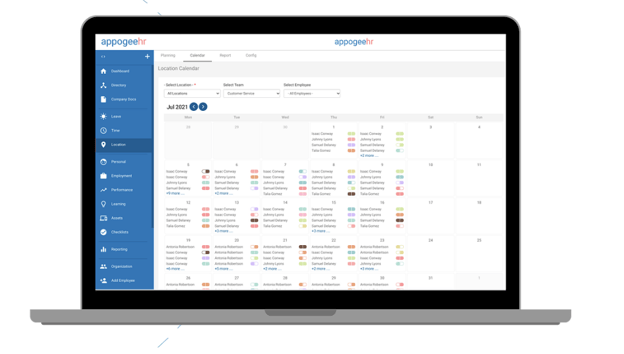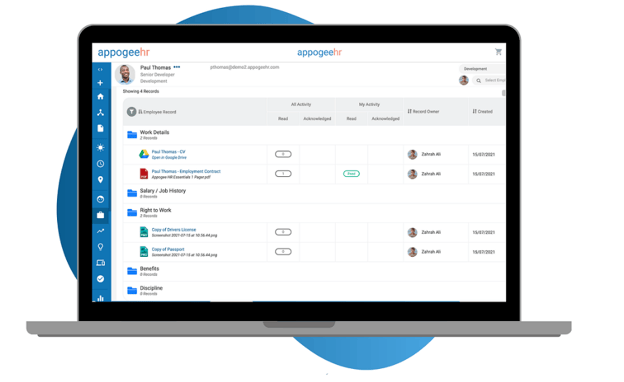HR trends for 2023
By Tara Clarke in HR Transformation
HR teams will need to adapt and revamp some of their strategies to succeed in what is set to be another challenging year ahead.
There’s little doubt that HR has undergone huge changes recently, particularly over the past couple of years. Adapting to an emerging workforce of remote and hybrid workers and retaining top talent, for example, saw the rise of automation and productivity tools–allowing HR teams to support businesses to stay ahead of the curve.
So what’s next?
Well, 2023 will see some HR trends gathering steam alongside some of the newest shifts and trends in the field of HR.
This article will share the top seven trends affecting HR teams and their possible solutions.
We’ll cover:
- Hybrid working
- Data-driven decisions
- Skills-based approach
- Upskilling middle managers
- Maintain focus on diversity and inclusion strategies
- Employee retention
- Employee listening
1. Hybrid working
As hybrid working becomes the permanent way of working, HR and business leaders need to set clear principles for success rather than apply a one-size-fits-all approach.
Study after study shows hybrid working is the new normal. In fact, an overwhelming 83% of workers say they prefer a hybrid model where they can work remotely at least 25% of the time. It’s why 90% of businesses say they will combine working at the office with remote work, according to McKinsey.
Not only that, over half of all employees (55%) said flexibility and work-life balance are essential aspects of their job satisfaction. That said, it is still surprising how only a few companies offer flexible working hours.
Why?
Because managing a remote and hybrid workforce takes time and effort. Amongst many other things, you’re unable to quickly glance around the office and see who is at work and who isn't.
Identify the people you are attracting and what model you are attracting. Offer a range of hybrid working arrangements that allow people to work around the life they want to lead. Grant a license for continual self-care and empower employees to make better choices about their work-life harmony.
A cloud-based location planner and time tracking solution, like Appogee HR Success, will give you full visibility of your workforce, regardless of where they work. 
Maintain accountability with work-from-home tracking software. Give your people choice by allowing staff to book time in the office so you can report on capacity management with ease.
2. Data-driven decisions
2023 will see a greater focus on people analytics and automation tools for senior executives and managers.
With over three-quarters of businesses agreeing that their HR department was “recognised by senior leaders as crucial to the business function”, there is still some improvement to make.
Businesses that don’t routinely use first-class HR reporting tools will fall behind. HR people have the ability to streamline and analyse people data–driving forward business goals by:
- Collecting information. HR teams have a raft of accurate, up-to-date information about workforce performance that allows leaders to make data-driven decisions. Solve critical business challenges, such as improving staff turnover rates or filling skills gaps with real-time metrics.
- Encouraging collaboration amongst teams and stakeholders. Robust data and analytics help you to strategize. Understand which direction you are going, how you will get there, and what might get in the way.
- Predicting future challenges. HR data and analytics can help businesses predict behaviour patterns and draw insights into how they perform. Make data-driven decisions about salaries, leavers, and headcounts–allowing you to get accurate and up-to-date information in a timely manner.
That’s what Dave Fenton, Vice President of Services at Ancoris felt when he implemented Appogee Time Tracker. He said, “The software really highlighted different working practices across departments and gave us the ability to properly define how to input data, and this has elevated utilisation up to board level to review activity every month from the company.”
Accurate data and people analytics support business leaders in making decisions based on real data, not just a hunch.
3. Skills-based approach
According to research, there has been a significant increase in skills-based hiring, up 63%, as businesses value employee experience over qualifications.
The fact is, degrees don’t prove that applicants have the hard and soft skills required for a job. Skills-based learning allows employers to improve employee performance by keeping teams up to speed with new technologies and ever-changing business demands. Not only that, an overwhelming 94% of employees will stay with a company if it offers learning and development opportunities.
Skill-based learning allows employees to use their full potential–creating opportunities for workers to troubleshoot problems and creating a sense of ownership and accountability.
Help employees climb the ladder with promotion and recruit from within. Plus, it’ll save you time and money associated with talent acquisition by targeting the right training for the right employees at the right time.
Create a learning culture that prioritises skills-based learning. Invest in goal setting and management software and align employee skills with your business strategy.
4. Upskilling middle managers
Why spend time and money teaching new candidates about your organisation, its values, and its goals when you can use the preexisting knowledge of middle managers?
According to Gallup, lack of unmanageable workloads, manager support, and poor communication was among the top causes of employee burnout. In fact, management and leadership skills are so significant that their behaviour can impact 70% of the changes in employee engagement. Plus, Pearson’s Skills Outlook identified leadership skills as one of the top five most sought-after skills businesses seek today.
Create opportunities for middle managers to upskill. They will be able to support staff through the increased cost of living with better listening, sensitivity, and confidence.
Allow middle managers to tackle their new responsibilities without having to learn the day-to-day standards of your operation.
Fast-track the next generation of leaders with quality performance management software. Record employee self-assessment and manager feedback using customisable topics, such as employee strengths and areas for development.
5. Maintain focus on diversity and inclusion strategies
2023 will see organisations actively embracing diversity, equity, inclusion, and belonging (DEI&B) across the employee lifecycle.
Given that men were still paid 8.3% more than women in 2022 among full-time employees, it’s clear equal pay is an ongoing issue.
Review your entire benefits programme, from salaries to benefits and promotions. Eliminate bias and discrimination from your hiring and internal promotion processes by assessing transferable skills, such as time management and problem-solving, rather than simply selecting applicants from previous work experience.
Secondly, foster a diverse, equitable, and inclusive workplace by using employee profiles and records to carry out regular pay audits. Understand whether employees are being unfairly compensated and take proactive steps to prevent pay disparity in the future.

Lastly, keep DEI&B at the forefront of your organisational culture. Share good practices and regular updates with employees with regular shoutouts and communications. Show your appreciation for exceptional diversity and inclusion practices.
6. Employee retention
The so-called “Great Resignation” shows no signs of stopping. The latest Global Workforce Hopes and Fears Survey 2022 from PwC found that one in five people worldwide plans to leave their job this year.
If you’re not already monitoring staff retention closely, you’re missing out on valuable insights that can prevent you from losing top talent and increasing business profits up to four times.
Plus, employees who quit can negatively affect those left behind. It creates uncertainty amongst employees, and some may even follow in their footsteps.
Retaining employees has considerable benefits for your organisation. Not only are you retaining an individual, but you’re also retaining their knowledge and skills.
Focus on certainty, not uncertainty, and improve employee retention rates by:
- Promoting positive work-life harmony across your workforce. Flexible working and wellness benefits, for example, can make employees feel you take their life outside of work as important.
- Nurturing relationships. Automate and streamline your key HR processes. An advanced HR management solution like Appogee HR Success will give managers more time to develop authentic relationships with team members.
- Supporting older members of your workforce. A one-size-fits-all approach isn’t going to help retain an aging workforce. By 2030, 47% of all over 50’s are expected to be part of the UK workforce. Provide tailored, compassionate care for employees. This could include access to counselling, retirement planning, and more.
Use employee records and profiles to examine data about leavers, sickness levels, employee turnover rates, and reasons for leaving. Think about what measures you can put in place now and create a workforce where employees want to stay, thrive and enjoy what they do.
7. Employee listening
How do you understand what’s happening across your workforce, and, more importantly, what can you do about it? Secondly, how do your employees feel about their employment? Thirdly, do you give your employees a voice?
These are just a few of the questions that employee listening activities will give you answers to.
The overall aim of employee listening is to aid workforce planning, improve employee experience and allow HR leaders to share key insights with the C-suite. It’s a continual process of speaking, listening, and analyzing staff feedback to put appropriate help and support in place and get their views on various topics. Yet, 60% of workers state that their employer has actively asked for their feedback, and almost all said that the organization did not take any action on their concerns.
That’s how Britt Chavers, Office and Human Resources Manager at ASE Direct felt when she upgraded their HR software to Appogee HR Success. She said, “This has given both our employees and managers a specific place to speak their truth and have everything organized in one spot.
“It has truly fostered a culture of learning and of growth because it allows everyone involved a safe space to vocalize their opinions and thoughts. It also has enabled opportunities to push employees forward in areas where they might have shortcomings.
“It gave ASE visibility for employees and managers to not only track time off but manage it proficiently. It’s extremely thorough and allows for deep customization to fit your organization’s needs”.
Employee listening in 2023 and beyond has never been more important. With the increase in utility bills and pay falling behind the inflation rate, let alone the industrial action for some employees, the impact on employee health and well-being can be detrimental. In fact, 59% of UK adults say that the cost of living crisis has left them feeling depressed or anxious. Even worse, 21% said they have felt unable to cope due to rising living costs.
Give all employees a voice. Ensure you are in tune with your workforce through meaningful employee listening activities, such as one-to-one meetings, regular check-ins, pulse surveys, and more. What’s more connect your employees by sharing the latest company news and initiatives, through internal communications and a company newsfeed.
Maintain employee motivation and monitor progress with an online employee portal. Put additional support measures in place as soon as they’re needed.
Are you prepared to meet 2023 head-on?
The last few years have been challenging for HR. The pandemic saw HR leaders transform how they carry out usual HR functions–modernising how they engage with employees whilst supporting business leaders.
But there’s little change ahead for 2023 and beyond. The trends we have listed are just some of the challenges HR teams face.
However, taking positive action now will create a workforce that not only empowers employees but also mitigates some of the HR challenges that lie ahead.
Our first-class HR and productivity solutions are designed to support businesses with current trends, allowing you to focus on other key priorities.
To learn more about Appogee HR Success, request a demo or try our software free for 14 days.
.webp?height=168&name=appogeehr%20(1).webp)




